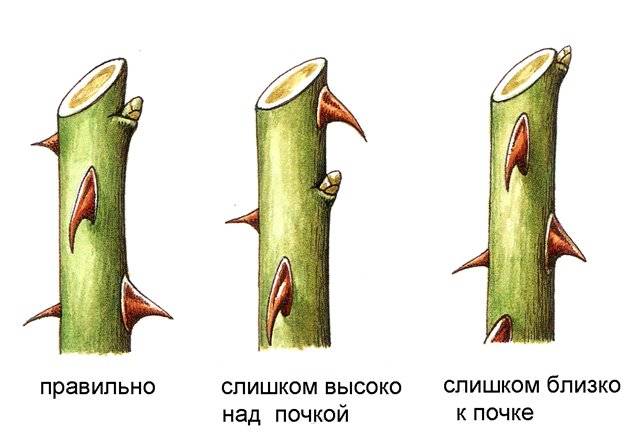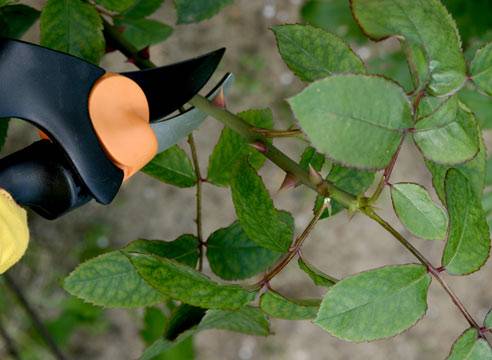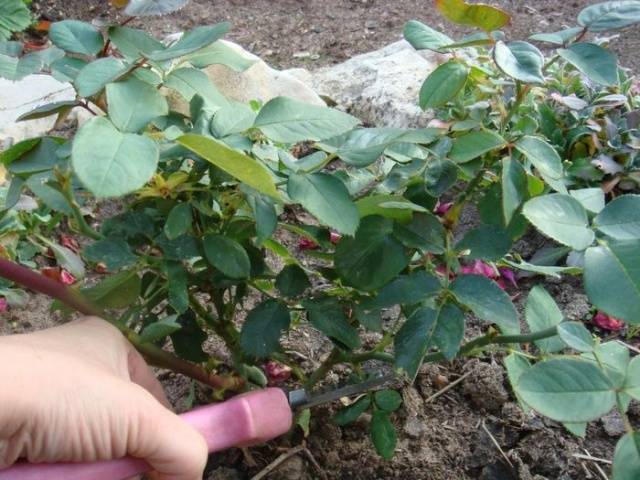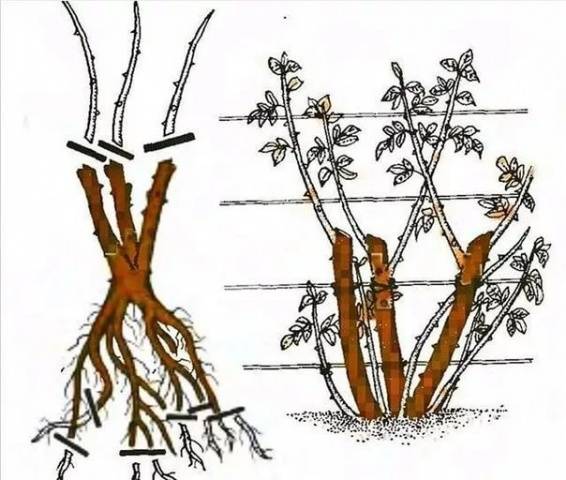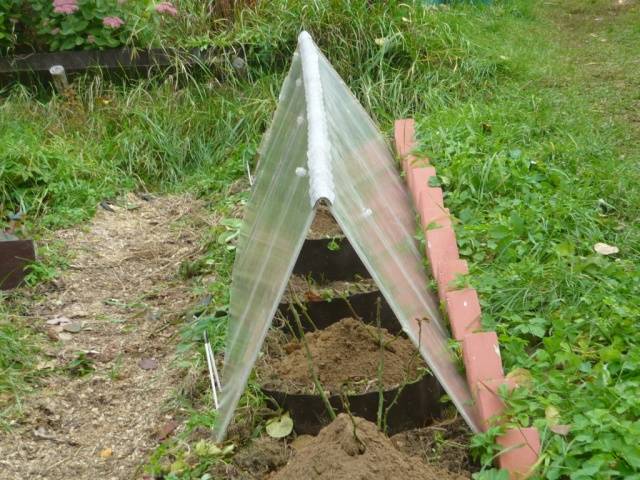Hybrid tea roses obtained as a result of selection work in the middle of the 19th century from old tea and remontant varieties of roses. Since then, they are the most beloved and most popular among gardeners. The roses took the best qualities from the parent varieties: resistance to temperature extremes and large flowers of various colors.
In many varieties, one shoot forms 1 flower each, which makes hybrid tea roses convenient for cutting. Modern varieties can form groups of flowers, which increases the decorative effect of the bush. Hybrid tea varieties have dark green leathery leaves, and the height of the bush can reach 1 m. Flowering lasts from mid-June to early October with a short break for 2 weeks.
How to prune hybrid tea roses for the winter
Before you start pruning hybrid tea roses for the winter, you should take care of a quality garden tool. You will need a well-sharpened pruning shears that will cut an even cut without crushing the stem. Before use, the pruner must be disinfected with potassium permanganate or Bordeaux liquid.
You should pay attention to the following rules when pruning roses.
The inclination of the cut is necessary from the kidney so that the water rolls down, and does not accumulate on the cut and does not drain to the kidney, which can rot from excess water.
The shoots that grow from the outer bud will grow outward, which will enable them to fully develop. Thus, a bowl-shaped or rounded bush will be laid, when the shoots grow in the outer circle without interfering with each other.
Autumn pruning of roses carried out in order to facilitate their concealment. Hybrid tea varieties tolerate winter well, but damaged shoots, leaves, unripe green shoots, as well as burgundy shoots that the plant released too late, and they do not have time to ripen, should be removed. Such shoots are called fattening. And they, more often than not, are doomed to death.
Another goal that is pursued when pruning is to ensure the growth of new shoots in the next growing season. With the growth of new shoots, new roots appear, the function of which is to feed the emerging shoots. A feature of hybrid tea roses is their increased regenerative capacity, which allows the bush to renew itself annually, prolonging its life. The life of rose bushes in one place can last more than a dozen years.
The question of removing leaves remains open and does not have an unambiguous answer. Moreover, many experienced rose growers with extensive experience do not recommend removing foliage at all. Since this is, first of all, hard work, if there are more than a dozen rose bushes in stock. After all, it is required to trim the leaves, and not tear them off, so as not to damage the bud.
It is believed that by removing the leaves, gardeners weaken the plant. In the spring, hybrid tea varieties cannot recover for a long time, even if the wintering was successful. This happens because heavily pruned roses with removed foliage cannot fully stock up the necessary trace elements for successful wintering.
Pruning of hybrid tea roses takes place in the last decade of October - early November. Pruning can be sparing or moderate when about half of the shoots are removed. This method of trimming will make it possible to make another pruning in springif the shoots are damaged by frost or disease.
Hybrid tea roses bloom both on old shoots and on new ones. First, I bloom old lignified shoots, and only then young ones, which makes it possible for roses to bloom continuously for a long time.
When planting seedlings, damaged roots are removed, long shoots are shortened by 2-3 buds, this will enable the plant to grow a rich green mass.
For 2 years, hybrid tea roses are shortened to 6 buds, this is about 20-30 cm from the soil level. The most powerful shoots are subjected to such pruning, weak shoots are shortened more, leaving 2-3 buds or 15 cm, stepping back from the soil surface.
How to prune hybrid tea roses, see the video:
There is an opinion among flower growers, which is based on many years of experience, that pruning in the fall of hybrid tea varieties is not needed. Do not injure the plant twice: in spring and autumn. During the winter, all the nutrients from the leaves and green shoots are gradually transferred to the roots and stems, supporting them in the cold period. By pruning greens, we deprive the rose bush of additional nutrition.
However, the question about hiding roses no doubt about it. Regardless of the region, hybrid tea roses require shelter. From the simplest shelter with spruce branches in the southern regions of the country to the device of more serious shelter structures in the middle lane, in Siberia and the Urals.
Preparing roses for winter
Preparation of hybrid tea roses for the winter cold begins at the end of summer. Nitrogen is excluded from dressings, fertilized with potassium-phosphorus fertilizers. If you have loamy soils, then you can feed with potassium sulfate, since loams are capable of accumulating phosphorus, and an excess of phosphorus will not be beneficial to plants.
Then the roses are pruned. Root circle spud soil or cover with a layer of mulch of 0.3-0.4 m. Mulch can be a mixture of soil, peat and sawdust, or your own garden soil with the addition of humus.
During the period when temperatures of at least -7 ° C are established, hybrid tea varieties are covered. For shelter, spruce branches or dry foliage are used. These are the simplest and most accessible materials. You can also use various garden waste, for example, faded plants torn from the flower bed along with the roots. They insulate hybrid tea roses well and create ventilation. Plants in such shelters feel good in winter, do not freeze and do not grow out. Before covering, hybrid tea roses are treated with copper-containing preparations.
You can wrap roses in agrofiber, burlap or thick paper. First, pull the branches to each other with twine, and only then insulate from above.
Another option for shelter is using arcs. If the roses are not cut in the fall, then they should be slightly bent. The distance between the stems and the upper part of the shelter should be at least 10-20 cm so that there is an air gap, thanks to which the plants will be protected from frost. The height of the arches is from 50-60 cm. It is impractical to do above, since the bushes in such a shelter can freeze.
Arcs from above are covered with geotextiles or any other non-woven covering material in 2-3 layers. They are securely fixed to the arches and to the soil so that the wind does not blow. You can also use a film, but then the shelter is left open at the ends so that the plants do not spill out, as condensation forms on the film. When the temperature reaches -7 ° C-10 ° C, all ventilation openings should be securely closed.
Another hiding place is for northern regions. A hut is made of boards, plywood or cellular polycarbonate, which is installed over hybrid tea roses. Shields made of boards or plywood are additionally covered with lutrasil in several layers, the top layer is turned with the smooth side, it does not allow moisture to pass through. At positive temperatures and a slight minus, the ends of the hut are not closed. But as soon as -5 ° С-7 ° С is established, the whole structure is covered.
Conclusion
Hybrid tea roses are a decoration for any garden that needs proper care. Only then will the plants delight you with abundant and long flowering.The choice is made by the florist himself, whether to cut the bushes for the winter or leave it as it is before spring pruning, how to cover the plant for the winter. If the choice is made in favor of pruning, then certain agrotechnical rules should be followed so that the roses remain healthy and do not waste energy on restoration in the next season.

